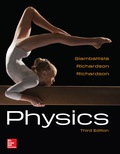
Concept explainers
(a)
Find the period of the pendulum for each horizontal axis.
(a)
Answer to Problem 103P
The period of the pendulum for each horizontal axis is
Explanation of Solution
Write the equation for time period of the physical pendulum.
Here,
Write the equation of the moment of inertia for uniform rod.
Here,
Conclusion:
Substitute equation (II) in equation (I) and replace
Substitute
Therefore, the time period of the pendulum for each horizontal axis is
(b)
Find the period of the pendulum for two rods.
(b)
Answer to Problem 103P
The time period of the pendulum for two rods is
Explanation of Solution
Consider the meter stick as two rods with lengths
Write the equation of the moment of inertia for
Here,
Write the equation of the moment of inertia for
Rewrite the equation (III).
Rewrite the equation (IV)
The total inertia of the two rods is.
Conclusion:
Substitute
Substitute
Therefore, the time period of the pendulum for two rods is
(c)
Find the period of the pendulum for two rods.
(c)
Answer to Problem 103P
The time period of the pendulum for two rods is
Explanation of Solution
Consider the meter stick as two rods with lengths
Write the equation of the moment of inertia for
Write the equation of the moment of inertia for
Rewrite the equation (V).
Rewrite the equation (VI)
The total inertia of the two rods is.
Conclusion:
Substitute
Substitute
Therefore, the time period of the pendulum for two rods is
Want to see more full solutions like this?
Chapter 10 Solutions
Physics
- Can someone help me with this physics 2 problem thank you.arrow_forwardCan someone help me with this physics 2 problem thank you.arrow_forwardTwo concrete spans of a 234 m long bridge are placed end to end so that no room is allowed for expansion (Figure a). Each span therefore has a length of L0 = 117 m. If the temperature increases by 17.8 °C, what is the height y to which the spans rise when they buckle (Figure b)? (The coefficient of linear expansion of concrete is 1.20⋅10−51.20⋅10-5 °C−1.)arrow_forward
- Monkey D. Luffy, from One Piece can inflate himself like a balloon to a size of 6.98 m3 by inhaling 1.74⋅10^26 molecules of air. If the air is at 20.9 ˚C, the pressure inside Luffy is 101277.062 Pa. kB=1.38⋅10^−23 J/K. The total internal energy of the gas inside Luffy is 1065333.93 J. How fast, on average, is the air molecules inside Luffy traveling at? The average mass of an air molecule (considering the various gasses involved) is 4.51 x 10^-26 kg.arrow_forwardThe Dungeons & Dragons spell “Stinking Cloud” fills a 949 m^3 volume of air with a cloud of gas. The pressure of the gas is the same as the air, 101,325 Pa, and is at 29.2°C. There are 2.304x10^28 molecules of gas. What is the total internal energy of the gas?arrow_forwardThe Fiero, which is 4.70 m long, starts at 10.0˚C while in the upper atmosphere but when it goes into space the temperature would be about -270.3˚C. How much should the steel siding of the Fiero shrink due to this temperature change? The coefficient of thermal linear expansion for steel is 11.0⋅10−6⋅10^-6 C-1arrow_forward
- Question 3 of 17 L X L L T 0.5/ In the figure above, three uniform thin rods, each of length L, form an inverted U. The vertical rods each have a mass m; the horizontal rod has a mass 3m. NOTE: Express your answer in terms of the variables given. (a) What is the x coordinate of the system's center of mass? xcom L 2 (b) What is the y coordinate of the system's center of mass? Ycom 45 L X Q Search MD bp Narrow_forwardSketch the harmonic on graphing paper.arrow_forwardExercise 1: (a) Using the explicit formulae derived in the lectures for the (2j+1) × (2j + 1) repre- sentation matrices Dm'm, (J/h), derive the 3 × 3 matrices corresponding to the case j = 1. (b) Verify that they satisfy the so(3) Lie algebra commutation relation: [D(Î₁/ħ), D(Î₂/h)]m'm₁ = iƊm'm² (Ĵ3/h). (c) Prove the identity 3 Dm'm,(β) = Σ (D(Ρ)D(Ρ))m'¡m; · i=1arrow_forward
 College PhysicsPhysicsISBN:9781305952300Author:Raymond A. Serway, Chris VuillePublisher:Cengage Learning
College PhysicsPhysicsISBN:9781305952300Author:Raymond A. Serway, Chris VuillePublisher:Cengage Learning University Physics (14th Edition)PhysicsISBN:9780133969290Author:Hugh D. Young, Roger A. FreedmanPublisher:PEARSON
University Physics (14th Edition)PhysicsISBN:9780133969290Author:Hugh D. Young, Roger A. FreedmanPublisher:PEARSON Introduction To Quantum MechanicsPhysicsISBN:9781107189638Author:Griffiths, David J., Schroeter, Darrell F.Publisher:Cambridge University Press
Introduction To Quantum MechanicsPhysicsISBN:9781107189638Author:Griffiths, David J., Schroeter, Darrell F.Publisher:Cambridge University Press Physics for Scientists and EngineersPhysicsISBN:9781337553278Author:Raymond A. Serway, John W. JewettPublisher:Cengage Learning
Physics for Scientists and EngineersPhysicsISBN:9781337553278Author:Raymond A. Serway, John W. JewettPublisher:Cengage Learning Lecture- Tutorials for Introductory AstronomyPhysicsISBN:9780321820464Author:Edward E. Prather, Tim P. Slater, Jeff P. Adams, Gina BrissendenPublisher:Addison-Wesley
Lecture- Tutorials for Introductory AstronomyPhysicsISBN:9780321820464Author:Edward E. Prather, Tim P. Slater, Jeff P. Adams, Gina BrissendenPublisher:Addison-Wesley College Physics: A Strategic Approach (4th Editio...PhysicsISBN:9780134609034Author:Randall D. Knight (Professor Emeritus), Brian Jones, Stuart FieldPublisher:PEARSON
College Physics: A Strategic Approach (4th Editio...PhysicsISBN:9780134609034Author:Randall D. Knight (Professor Emeritus), Brian Jones, Stuart FieldPublisher:PEARSON





